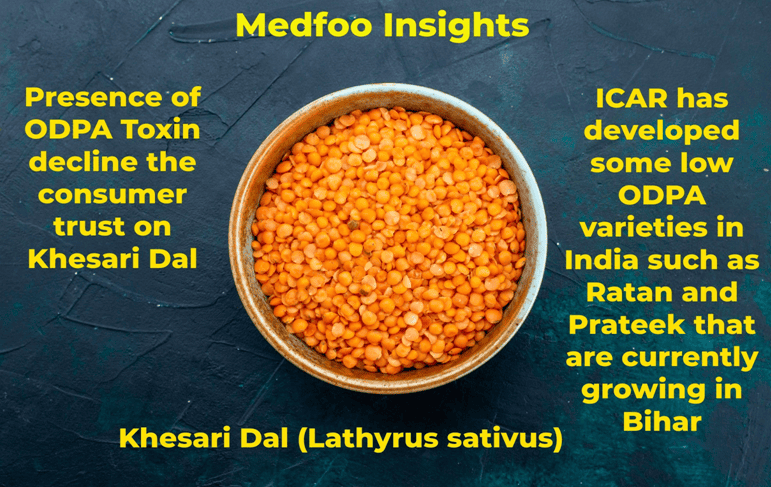Khesari Dal (Lathyrus sativus): Sustainable solution to the global food security in near future

What is khesari dal?
It is the legume food obtained from the primary processing i.e. milling of khesari grains.
Khesari dal looks like pigeon pea/Tur/Arhar Dal
It is similar to pigeon pea which is commonly known as Arhar or Tur dal in India. This is the reason that as a fraudulent practice, people adulterate the pigeon pea with khesari dal. Observing these illegal practices, the FSSAI established the regulation in this regard i.e. not more than 2 % of the khesari dal can be mixed in the pulses.
Why khesari dal (Lathyrus sativus) is banned for human consumption?
It is said that due to the presence of ODPA toxin (Oxyldiaminopropionic acid) that may cause paralysis of the lower body part, the khesari dal is banned.
Probable reason for Lathyrism
It is said that during 1942-44, when most of the crops were destroyed due to famine, particularly potatoes and that’s why the burden of people’s consumption was upheld by Khesari Dal. So, people consumed a greater fraction of khesari Dal in those days than it was consumed in the Pre-famine period. It is a scientific temperament that due to the over-consumption of khesari Dal as it was cheap, some cases of lathyrism were reported.
Antagonistic Reports Against Lathyrism
Some Agriculture extension scientists visited the villages in east U.P. where they interacted with villagers and they got unexpected responses about khesari Dal. The responses are been listed below point-wise:
- The Khesari Dal has enormous drought-tolerant attributes and that’s why when, during the famine, most of the crops were destroyed due to drought, khesari still maintained its productivity.
- People used to eat khesari dal full of their bellies even though no case of paralysis was reported according to villagers.
Khesari Dal (Lathyrus sativus) status in India
In India, khesari Dal was banned in 1961 and the ban was uncapped in some states viz., Maharashtra, Chhattisgarh, Bihar, and West Bengal in 2016 while it is still banned in remaining states of India including Uttar Pradesh and other Hindi belt states.
Several agitations were done by social activists, and scientists such as Dr. Kothari, and Dr. S.L.N. Rao to convince the Indian government to lift the ban on the crop. But, the govt. officials were not influenced due to a lack of sufficient empirical data on the research in support of their statement. The scientists/researchers conducted several studies on animal models such as Monkeys, Horses, Cow, Rabbit, and other animals to see the effect of ODPA.
Production of Khesari Dal in India
Khesari Dal is the cheapest among the pulses thats why it is said to be known as “Poor Man’s Pulse”. The agriculture ministry estimates that khesari is produced annually on between 280,000 and 350,000 tonnes of land spread across 400,000–500,000 hectares in the states of Madhya Pradesh, Chhattisgarh, Maharashtra, Bihar, and West Bengal which are the largest khesari Dal growing state in India.
Lathyrus sativus is a key eliminator of food security issues globally
Lathyrus sativus is a drought-tolerant crop that can grow in extreme climatic conditions or drought-prone environments such as the high temperature of the sub-Saharan region and in extreme low-temperature conditions as well.
That’s why Lathyrus sativus is the most important crop to address the food security issues in the world as it can grow in infertile soil with good production supporting sustainable agriculture.
The John Innes Centre is working to develop new toxin-free varieties of Lathyrus sativus with genetic modification and they raised the 2.1 Million Euro fund under the Sustainable Agriculture for Sub-Saharan Africa (SASSA) fund.
The Lathyrus sativus (Khesari Dal) is banned in most of regions the world due to the presence of ODPA (Oxyldiaminopropionic acid) toxin claimed to cause paralysis of lower body parts in human beings and certain mammals as well.


